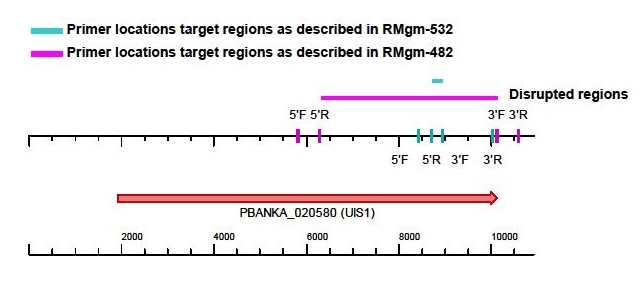Back to search resultsSummaryRMgm-532
|
||||||||
 *RMgm-532
*RMgm-532| Successful modification | The parasite was generated by the genetic modification |
| The mutant contains the following genetic modification(s) | Gene disruption |
| Reference (PubMed-PMID number) |
Reference 1 (PMID number) : 20951971 |
| MR4 number | |
| top of page | |
| Parent parasite used to introduce the genetic modification | |
| Rodent Malaria Parasite | P. berghei |
| Parent strain/line | P. berghei ANKA |
| Name parent line/clone | P. berghei ANKA 2.34 |
| Other information parent line | P. berghei ANKA 2.34 is a cloned, gametocyte producer line of the ANKA strain (PubMed: PMID: 15137943). |
| top of page | |
| The mutant parasite was generated by | |
| Name PI/Researcher | R. Tewari, O. Billker |
| Name Group/Department | University of Nottingham |
| Name Institute | University of Nottingham |
| City | Nottingham |
| Country | UK |
| top of page | |
| Name of the mutant parasite | |
| RMgm number | RMgm-532 |
| Principal name | K42 eik2 |
| Alternative name | |
| Standardized name | |
| Is the mutant parasite cloned after genetic modification | Yes |
| top of page | |
| Phenotype | |
| Asexual blood stage | Not different from wild type |
| Gametocyte/Gamete | Not different from wild type |
| Fertilization and ookinete | Ookinete numbers (in vitro) reduced to 52% of wild type |
| Oocyst | Oocyst numbers (day 12-14) reduced to 20% of wild type |
| Sporozoite | Not different from wild type |
| Liver stage | transmitted by mosquito bite |
| Additional remarks phenotype | The gene has been targeted for gene deletion using a construct aimed at integration into the genome by double cross-over homologous recombination The gene has been targeted for disruption in a 'kinome-wide' study for deletion of genes encoding Plasmodium protein kinases (protein kinase-like proteins). See the paper for additional information on the analysis of the phenotype. See RMgm-482 for an independen mutant lacking expression of PBANKA_020580. Phenotype analyses of this mutant showed the following characteristics: Fertilisation and ookinete formation NOT different from wild type; Oocyst production and development NOT different from wild type; Normal numbers of salivary gland sporozoites; Sporozoites showed reduced gliding motility and cell traversal capacity in vitro. Invasion of HepG2 cells in vitro was comparable to that of wild type parasites. Infectivity of sporozoites to mice was strongly reduced (as tested by intravenous injection of purified sporozoites or after infection of mice by mosquito bite). Salivary gland sporozoites show premature development into early liver stage forms. See below for a picture showing the location of the target regions used to disrupt PBANKA_020580 in the mutant described here and for mutant RMgm-482
Disruption of the P. falciparum ortholog has been attempted (Solyakov et al., 2011, Nat Commun, 2:565). After transfection with a KO vector a strong PCR signal diagnostic for gene disruption was observed in transfected populations indicating that this gene is not essential for asexual proliferation. Cloning will however be required to validate this interpretation for this |
 Disrupted: Mutant parasite with a disrupted gene
Disrupted: Mutant parasite with a disrupted gene| top of page | |||||||||||||||||||||||||
| Details of the target gene | |||||||||||||||||||||||||
| Gene Model of Rodent Parasite | PBANKA_0205800 | ||||||||||||||||||||||||
| Gene Model P. falciparum ortholog | PF3D7_0107600 | ||||||||||||||||||||||||
| Gene product | serine/threonine protein kinase, putative | ||||||||||||||||||||||||
| Gene product: Alternative name | initiation factor 2alpha (eIF2alpha) kinase 2 | ||||||||||||||||||||||||
| top of page | |||||||||||||||||||||||||
| Details of the genetic modification | |||||||||||||||||||||||||
| Inducable system used | No | ||||||||||||||||||||||||
| Additional remarks inducable system | |||||||||||||||||||||||||
| Type of plasmid/construct used | Plasmid double cross-over | ||||||||||||||||||||||||
| PlasmoGEM (Sanger) construct/vector used | No | ||||||||||||||||||||||||
| Modified PlasmoGEM construct/vector used | No | ||||||||||||||||||||||||
| Plasmid/construct map | |||||||||||||||||||||||||
| Plasmid/construct sequence | |||||||||||||||||||||||||
| Restriction sites to linearize plasmid | |||||||||||||||||||||||||
| Partial or complete disruption of the gene | Partial | ||||||||||||||||||||||||
| Additional remarks partial/complete disruption | partial (insertion/deletion in 3' kinase domain) | ||||||||||||||||||||||||
| Selectable marker used to select the mutant parasite | tgdhfr | ||||||||||||||||||||||||
| Promoter of the selectable marker | pbdhfr | ||||||||||||||||||||||||
| Selection (positive) procedure | pyrimethamine | ||||||||||||||||||||||||
| Selection (negative) procedure | No | ||||||||||||||||||||||||
| Additional remarks genetic modification | |||||||||||||||||||||||||
| Additional remarks selection procedure | |||||||||||||||||||||||||
|
Primer information: Primers used for amplification of the target sequences
 Primer information: Primers used for amplification of the target sequences

| |||||||||||||||||||||||||
| top of page | |||||||||||||||||||||||||

